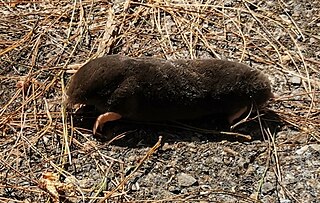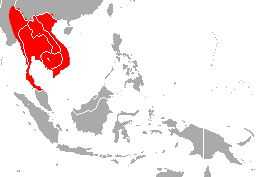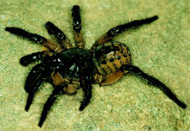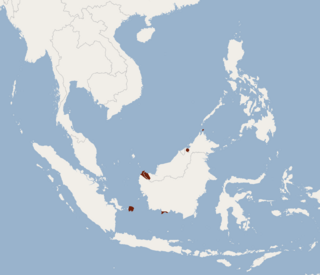
The sun bear is a species in the family Ursidae occurring in the tropical forests of Southeast Asia. It is the smallest bear species, standing nearly 70 cm (28 in) at the shoulder and weighing 25–65 kg (55–143 lb). It is stockily built, with large paws, strongly curved claws, small, rounded ears and a short snout. The fur is generally short and jet black, but can vary from grey to red. The sun bear gets its name from its characteristic orange to cream-coloured chest patch. Its unique morphology—inward-turned front feet, flattened chest, powerful forelimbs with large claws—suggests adaptations for climbing.

The dayak fruit bat or dyak fruit bat is a relatively rare frugivorous megabat species found only on the Sunda Shelf of southeast Asia, specifically the Malay Peninsula south of the Isthmus of Kra, and the islands of Borneo and Sumatra. There are three species in the genus Dyacopterus: D. spadiceus, D. brooksi and D. rickarti. All are found in the forests of Malaysia, Thailand, and the Philippines. Few specimens of any of the three species exist, due not only to their rarity, but also because they rarely enter the sub-canopy of the forest where they can be caught in scientists' nets.

Bukit Larut is a hill resort in Malaysia located in the state of Perak, Malaysia, 10 kilometres southwest from Taiping. It was established under the direction of British colonists in 1884 as a place of observation for tin mining activity and as a retreat for the English people who were based in nearby Larut and Taiping. The area was initially named Maxwell Hill after the British Malaya administrator George Maxwell, and was renamed as Bukit Larut in 1979.

The black hornbill is a species of bird of the hornbill family Bucerotidae. It lives in Asia in Brunei Darussalam, Indonesia, Malaysia, Singapore, Thailand.

The black-and-crimson oriole is a species of bird in the family Oriolidae.

Euroscaptor is a genus of mammal in the family Talpidae. Members are found in China and South & Southeast Asia. It contains the following species as of October 2021:

Kloss's mole is a species of mammal in the family Talpidae. It is found in Laos and Thailand. It was named after zoologist C. Boden Kloss.

The Himalayan mole or short-tailed mole is a species of mammal in the family Talpidae.

The Malayan pygmy shrew is a species of mammal in the family Soricidae. It can be found in Malaysia and Thailand. Its natural habitat is subtropical or tropical dry forests.

The Malayan horseshoe bat is a species of bat in the family Rhinolophidae. It is found in Cambodia, Laos, Malaysia, Myanmar, Thailand, and Vietnam.
Kostermanthus malayanus is a species of plant in the family Chrysobalanaceae. It is endemic to Peninsular Malaysia. It is threatened by habitat loss.

Liphistius is a genus of basal trapdoor spiders in the family Liphistiidae. They are found in Japan, China, and Southeast Asia.

The cave nectar bat, dawn bat, common dawn bat, common nectar bat or lesser dawn bat is a species of megabat within the genus Eonycteris. The scientific name of the species was first published by Dobson in 1871.

The Muar District is a district in Johor, Malaysia. Muar is located at the mouth of the Muar River, on the coast of the Straits of Malacca. The Muar District covers 1,354 km2 (523 sq mi), with a population of 233,779 (2010).

The Borneo lowland rain forests is an ecoregion, within the tropical and subtropical moist broadleaf forests biome, of the large island of Borneo in Southeast Asia. It supports approximately 15,000 plant species, 380 bird species and several mammal species. The Borneo lowland rain forests is diminishing due to logging, hunting and conversion to commercial land use.

The Vordermann's pipistrelle is a species of vesper bat found in Brunei Darussalam, Indonesia, and Malaysia. It was described in 1890 by the Dutch zoologist Fredericus Anna Jentink, who named it after its discoverer, the Dutch physician Adolphe Vorderman.
The COVID-19 pandemic in Selangor, Malaysia, started when four of eight Chinese nationals from Wuhan was quarantined in a hotel of Johor's Iskandar Puteri was tested positive on 25 January and 28 January 2020, respectively, and was quarantined in Sungai Buloh Hospital, largest hospital of Selangor. As of 24 October, Selangor confirmed more than 700,000 cases and over 7,000 deaths. Making it the worst effected state in Malaysia
Acrogomphus is a genus of dragonfly.















